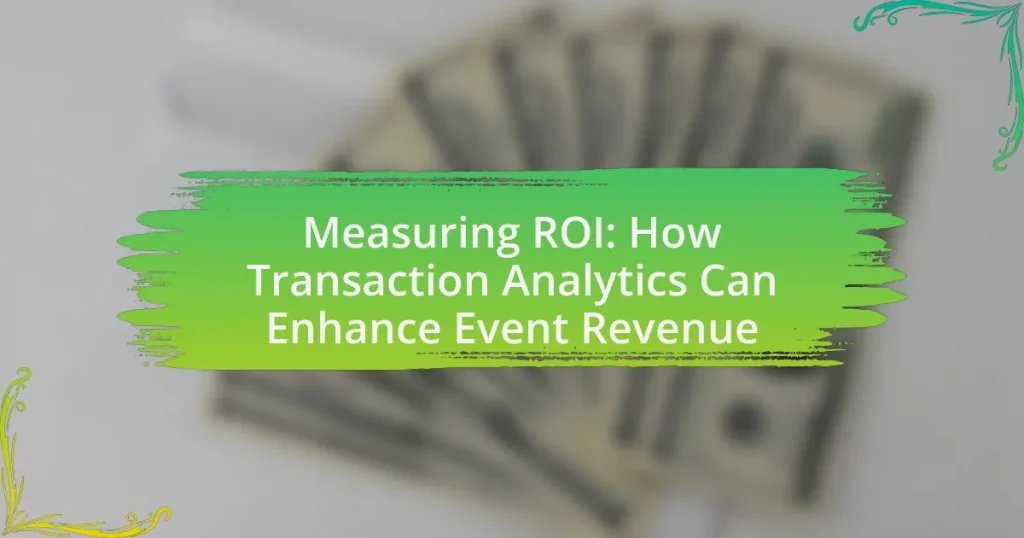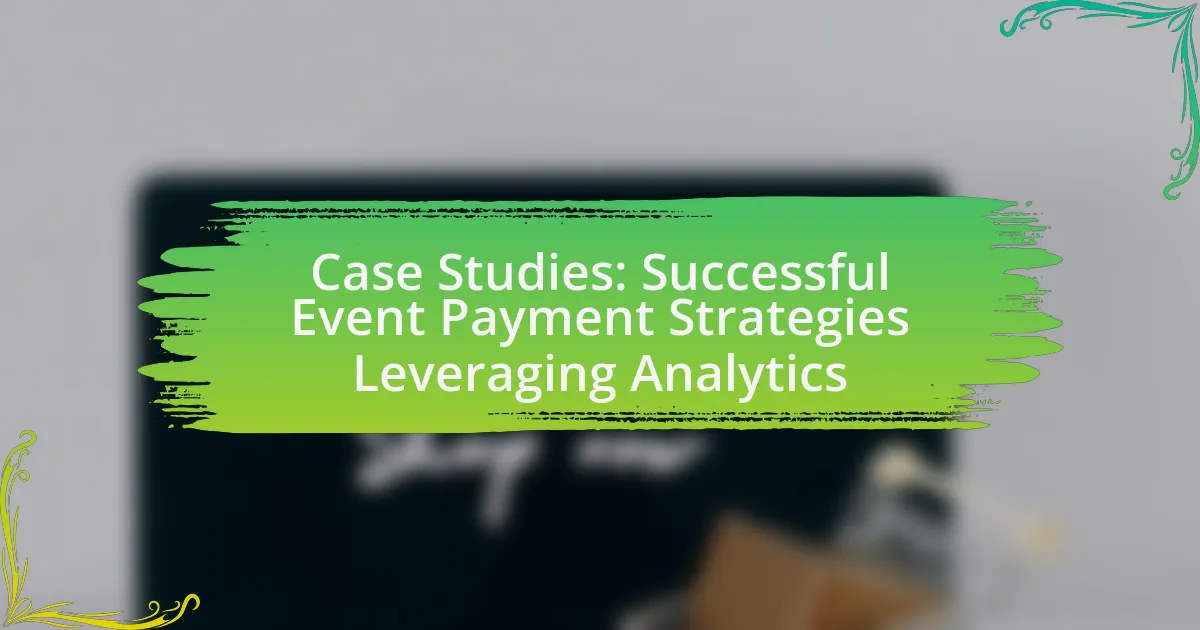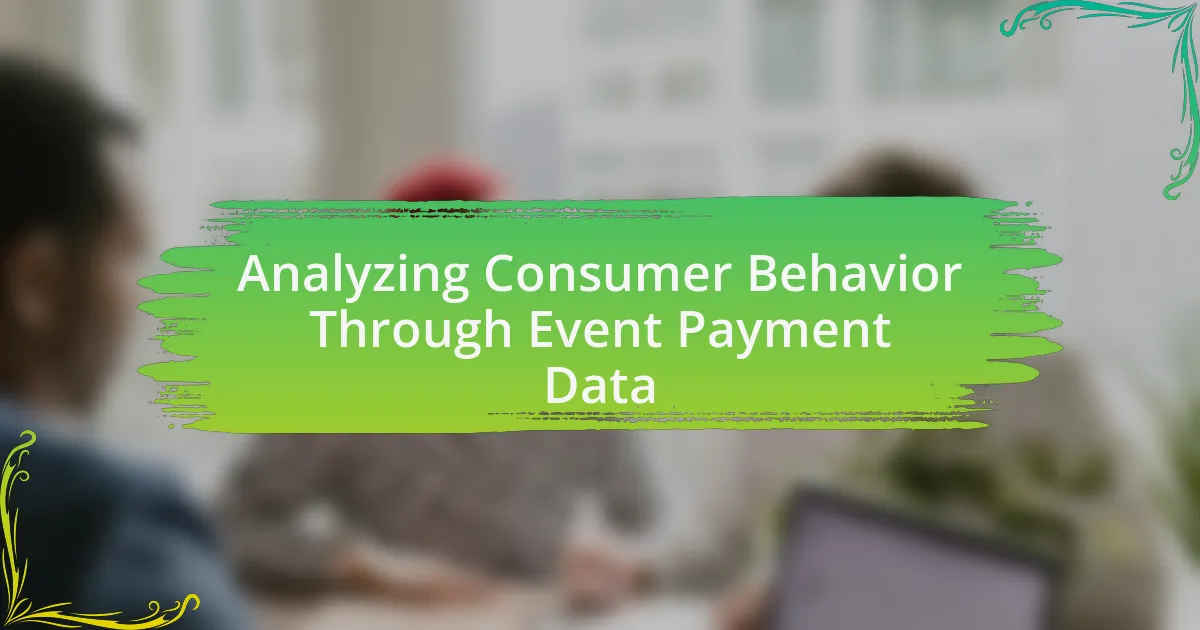Measuring ROI in event revenue is a critical process that evaluates the financial return generated from events relative to their costs. This article outlines the importance of ROI calculations, utilizing metrics such as total revenue, total costs, and attendee numbers to assess event profitability. It emphasizes the role of transaction analytics in providing insights into customer behavior and enhancing decision-making for future events. Additionally, the article discusses the challenges event organizers face in measuring ROI, the benefits of data accuracy, and best practices for leveraging transaction analytics to maximize revenue.
What is Measuring ROI in Event Revenue?
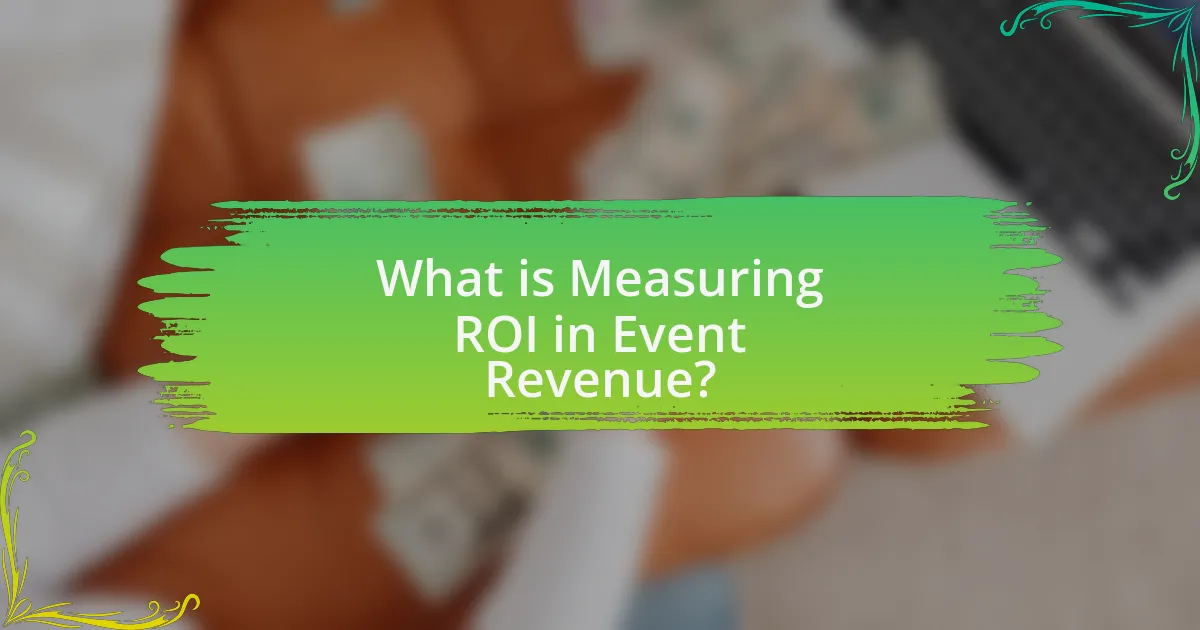
Measuring ROI in event revenue refers to the process of evaluating the financial return generated from an event relative to its costs. This measurement is crucial for understanding the effectiveness of an event in generating profit and justifying the investment made. To calculate ROI, the formula used is (Net Profit / Total Costs) x 100, where net profit is derived from total revenue minus total expenses associated with the event. For instance, if an event generates $100,000 in revenue and incurs $60,000 in costs, the ROI would be (40,000 / 60,000) x 100, resulting in a 66.67% return on investment. This quantifiable metric allows event organizers to assess performance, make informed decisions for future events, and optimize resource allocation.
How is ROI defined in the context of event revenue?
ROI, or Return on Investment, in the context of event revenue is defined as the ratio of net profit generated from an event to the total costs incurred in organizing that event. This calculation allows event organizers to assess the financial effectiveness of their events by measuring how much revenue is generated for every dollar spent. For instance, if an event generates $100,000 in revenue and costs $50,000 to organize, the ROI would be calculated as ($100,000 – $50,000) / $50,000, resulting in an ROI of 1.0 or 100%. This metric is crucial for understanding the profitability of events and guiding future investment decisions.
What metrics are used to calculate ROI for events?
The primary metrics used to calculate ROI for events include total revenue generated, total costs incurred, and the number of attendees. Total revenue generated encompasses ticket sales, sponsorships, and merchandise sales, while total costs incurred cover venue rental, marketing expenses, and staffing costs. The ROI formula is typically expressed as (Total Revenue – Total Costs) / Total Costs. This formula allows event organizers to assess the financial effectiveness of their events. For instance, a study by the Event Marketing Institute found that 79% of marketers believe that events are critical to their company’s success, highlighting the importance of accurately measuring ROI to justify event expenditures.
Why is measuring ROI important for event organizers?
Measuring ROI is crucial for event organizers because it quantifies the financial return on investment from events, enabling informed decision-making. By analyzing ROI, organizers can assess the effectiveness of their strategies, allocate resources efficiently, and identify areas for improvement. For instance, a study by the Event Marketing Institute found that 79% of event marketers consider measuring ROI essential for justifying budgets and demonstrating value to stakeholders. This data underscores the importance of ROI measurement in optimizing event performance and enhancing overall revenue.
What role does transaction analytics play in measuring ROI?
Transaction analytics plays a crucial role in measuring ROI by providing detailed insights into customer behavior and financial performance. By analyzing transaction data, organizations can identify trends, assess the effectiveness of marketing strategies, and determine the profitability of specific events or campaigns. For instance, a study by McKinsey & Company found that companies leveraging transaction analytics can improve their marketing ROI by up to 15% through targeted customer engagement and optimized pricing strategies. This data-driven approach enables businesses to make informed decisions that enhance revenue generation and maximize return on investment.
How do transaction analytics provide insights into event performance?
Transaction analytics provide insights into event performance by analyzing data related to sales, attendance, and customer behavior during events. This analysis allows event organizers to identify trends, such as peak purchasing times and popular ticket types, which can inform future event planning and marketing strategies. For instance, a study by Eventbrite found that events with targeted marketing based on transaction data saw a 20% increase in ticket sales. By leveraging transaction analytics, organizations can optimize pricing strategies and enhance customer engagement, ultimately leading to improved revenue outcomes.
What types of data are analyzed in transaction analytics?
Transaction analytics primarily analyzes sales data, customer behavior data, and operational data. Sales data includes transaction amounts, product details, and purchase frequency, which help identify revenue trends and customer preferences. Customer behavior data encompasses demographics, purchase history, and engagement metrics, providing insights into customer loyalty and segmentation. Operational data involves inventory levels, supply chain metrics, and transaction processing times, which are essential for optimizing efficiency and resource allocation. These data types collectively enable organizations to assess performance, enhance decision-making, and ultimately improve event revenue.
How can transaction analytics enhance event revenue?
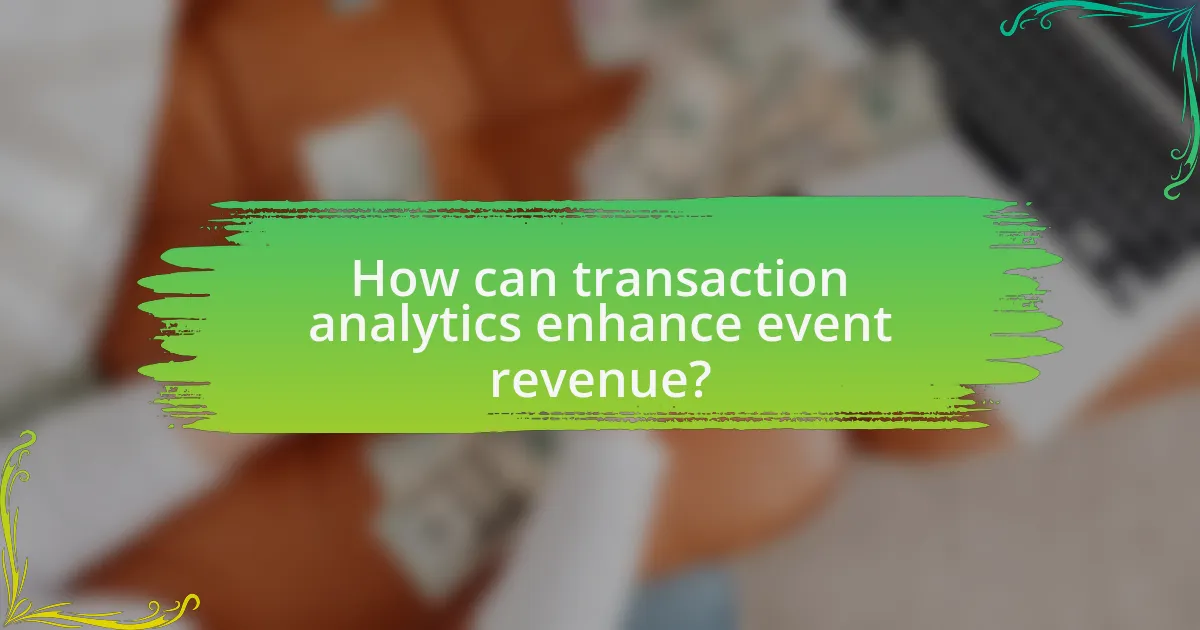
Transaction analytics can enhance event revenue by providing insights into customer purchasing behaviors and preferences, enabling targeted marketing strategies. By analyzing transaction data, event organizers can identify trends, optimize pricing models, and tailor offerings to meet the specific needs of attendees. For instance, a study by Eventbrite found that events utilizing data analytics saw a 20% increase in ticket sales by effectively targeting promotions to specific demographics. This data-driven approach allows for better resource allocation and maximizes revenue potential through informed decision-making.
What specific benefits do transaction analytics offer for event revenue?
Transaction analytics provide several specific benefits for event revenue, including enhanced decision-making, improved pricing strategies, and increased customer insights. By analyzing transaction data, event organizers can identify trends in attendee purchasing behavior, allowing for more informed decisions regarding marketing and promotional strategies. For instance, understanding peak purchasing times can help optimize ticket sales and maximize revenue. Additionally, transaction analytics enable organizers to refine pricing models based on demand elasticity, ensuring that ticket prices align with attendee willingness to pay. Furthermore, these analytics offer valuable insights into customer demographics and preferences, facilitating targeted marketing efforts that can lead to higher attendance and revenue. Overall, leveraging transaction analytics leads to more strategic planning and execution, ultimately enhancing event revenue.
How can transaction analytics identify revenue opportunities?
Transaction analytics can identify revenue opportunities by analyzing customer purchasing patterns and behaviors to uncover trends and preferences. By examining transaction data, businesses can pinpoint which products or services are most popular, identify cross-selling and upselling opportunities, and optimize pricing strategies. For instance, a study by McKinsey found that companies leveraging transaction analytics can increase their revenue by 10-20% by tailoring their offerings based on customer insights. This data-driven approach enables organizations to make informed decisions that directly enhance revenue generation.
What patterns can transaction analytics reveal about attendee behavior?
Transaction analytics can reveal patterns in attendee behavior such as spending habits, purchase timing, and product preferences. By analyzing transaction data, event organizers can identify which items are most frequently purchased, peak purchasing times during the event, and the demographics of attendees making specific purchases. For instance, a study by Eventbrite found that attendees who purchase tickets early tend to spend more on additional services, indicating a correlation between early ticket sales and higher overall spending. This data allows organizers to tailor marketing strategies and optimize inventory, ultimately enhancing event revenue.
How can event organizers implement transaction analytics effectively?
Event organizers can implement transaction analytics effectively by utilizing data collection tools that track attendee purchases and engagement metrics in real-time. By integrating point-of-sale systems and online ticketing platforms, organizers can gather comprehensive data on sales patterns, customer preferences, and revenue streams. This data can then be analyzed using analytics software to identify trends, optimize pricing strategies, and enhance marketing efforts. For instance, a study by Eventbrite found that events leveraging transaction analytics saw a 20% increase in ticket sales by tailoring their offerings based on consumer behavior insights.
What tools are available for transaction analytics in events?
Tools available for transaction analytics in events include software platforms such as Eventbrite, Cvent, and Whova. These platforms provide features for tracking ticket sales, attendee engagement, and revenue generation. For instance, Eventbrite offers real-time reporting on ticket sales and attendee demographics, enabling event organizers to analyze performance metrics effectively. Cvent provides comprehensive analytics tools that help measure event ROI by tracking expenses and revenue against set goals. Whova enhances transaction analytics by integrating attendee feedback and engagement data, allowing for a holistic view of event success.
How can data from transaction analytics be integrated into event planning?
Data from transaction analytics can be integrated into event planning by analyzing purchasing behaviors and preferences to tailor event offerings. This integration allows planners to identify which products or services are most popular among attendees, enabling them to optimize pricing strategies and enhance marketing efforts. For instance, a study by Eventbrite found that events that utilized data-driven insights saw a 20% increase in ticket sales. By leveraging transaction data, event planners can also forecast demand more accurately, ensuring adequate inventory and resources, ultimately leading to improved attendee satisfaction and increased revenue.
What challenges exist in measuring ROI with transaction analytics?
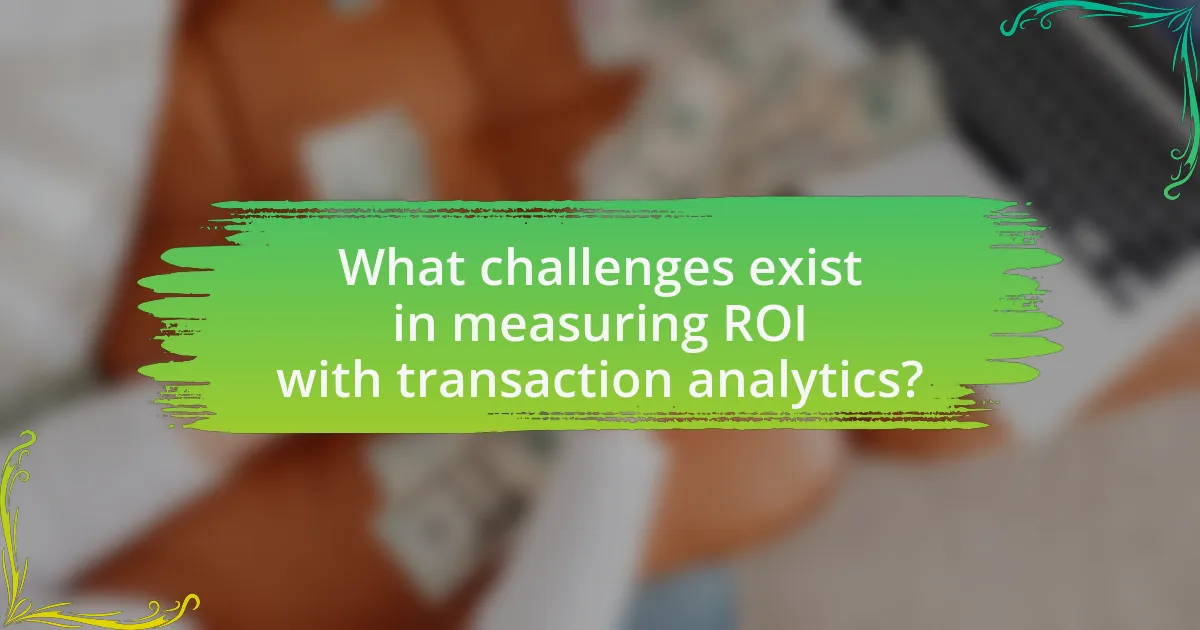
Measuring ROI with transaction analytics faces several challenges, primarily due to data integration, accuracy, and attribution issues. Data integration challenges arise when organizations struggle to consolidate data from various sources, leading to incomplete or inconsistent datasets. Accuracy issues stem from potential errors in transaction data, which can skew ROI calculations. Attribution challenges occur when determining which transactions directly contribute to revenue, complicating the assessment of marketing effectiveness. These factors collectively hinder the ability to derive clear and actionable insights from transaction analytics, making it difficult to accurately measure ROI.
What common obstacles do event organizers face?
Event organizers commonly face obstacles such as budget constraints, logistical challenges, and attendee engagement issues. Budget constraints limit the resources available for marketing, venue selection, and overall event execution, often leading to compromises in quality. Logistical challenges include coordinating vendors, managing timelines, and ensuring compliance with regulations, which can disrupt the event flow. Attendee engagement issues arise from difficulties in attracting and retaining participants, impacting overall satisfaction and perceived value. These obstacles can significantly hinder the success of an event, as evidenced by industry reports indicating that 60% of event planners cite budget limitations as a primary concern, while 50% struggle with logistics and attendee engagement.
How can data accuracy impact ROI measurement?
Data accuracy significantly impacts ROI measurement by ensuring that the financial metrics used to calculate return on investment are reliable and valid. Accurate data allows organizations to make informed decisions based on precise revenue figures and cost assessments, leading to a clearer understanding of profitability. For instance, a study by the Data Warehousing Institute found that organizations with high data quality can achieve up to 20% higher ROI compared to those with poor data quality. This correlation underscores the necessity of accurate data in effectively measuring and optimizing ROI.
What are the limitations of transaction analytics in event revenue analysis?
Transaction analytics in event revenue analysis has several limitations, including a narrow focus on quantitative data, which can overlook qualitative factors influencing revenue. This approach primarily captures financial transactions, neglecting aspects such as customer experience, brand perception, and engagement levels that significantly impact overall revenue. Additionally, transaction analytics may not account for external variables like market trends or economic conditions, leading to incomplete insights. Furthermore, reliance on historical data can result in a lag in responsiveness to real-time changes in consumer behavior, limiting the ability to adapt strategies promptly. These limitations highlight the need for a more holistic approach that integrates both quantitative and qualitative data for comprehensive event revenue analysis.
How can event organizers overcome these challenges?
Event organizers can overcome challenges by implementing transaction analytics to gain insights into attendee behavior and preferences. By analyzing data from ticket sales, merchandise purchases, and attendee interactions, organizers can identify trends and optimize pricing strategies. For instance, a study by Eventbrite found that events utilizing data analytics saw a 20% increase in revenue due to targeted marketing and improved attendee experiences. This data-driven approach allows organizers to make informed decisions, enhance engagement, and ultimately boost return on investment (ROI).
What best practices can improve data collection and analysis?
Implementing standardized data collection methods significantly improves data collection and analysis. Standardization ensures consistency across data points, which enhances the reliability of the analysis. For instance, using uniform survey instruments or data entry protocols can reduce errors and facilitate easier comparison of data over time. Additionally, leveraging technology such as automated data collection tools can streamline the process, minimize human error, and increase efficiency. Research indicates that organizations employing standardized methods see a 30% increase in data accuracy, which directly impacts the quality of insights derived from the analysis.
How can collaboration with data analysts enhance ROI measurement?
Collaboration with data analysts enhances ROI measurement by providing data-driven insights that improve decision-making and strategy formulation. Data analysts utilize advanced statistical techniques and tools to analyze transaction data, identifying trends and patterns that inform revenue generation strategies. For instance, a study by McKinsey & Company found that organizations leveraging data analytics can increase their profitability by 5-6% on average. This collaboration allows businesses to accurately attribute revenue to specific events or marketing efforts, ensuring that ROI calculations are based on comprehensive and precise data rather than assumptions.
What are the best practices for maximizing ROI through transaction analytics?
To maximize ROI through transaction analytics, organizations should focus on data integration, real-time analysis, and actionable insights. Data integration ensures that all relevant transaction data from various sources is consolidated, allowing for a comprehensive view of customer behavior and spending patterns. Real-time analysis enables businesses to respond swiftly to trends and anomalies, optimizing pricing strategies and inventory management. Actionable insights derived from transaction data can guide marketing efforts and enhance customer engagement, leading to increased sales and improved customer retention. According to a study by McKinsey, companies that leverage advanced analytics can improve their marketing ROI by 15-20%.
How can continuous improvement be achieved in event revenue strategies?
Continuous improvement in event revenue strategies can be achieved by implementing data-driven decision-making processes that utilize transaction analytics. By analyzing past event performance data, organizations can identify trends, optimize pricing strategies, and enhance marketing efforts to increase attendance and revenue. For instance, a study by Eventbrite found that events leveraging data analytics saw a 20% increase in ticket sales compared to those that did not. This demonstrates that continuous monitoring and adjustment based on analytics can lead to significant revenue growth in event management.
What role does feedback play in refining transaction analytics approaches?
Feedback plays a critical role in refining transaction analytics approaches by providing insights that enhance data accuracy and decision-making. When organizations collect feedback from users and stakeholders, they can identify gaps in their analytics processes, leading to improved methodologies and more relevant data interpretations. For instance, feedback can reveal discrepancies in transaction data, prompting adjustments that ensure more reliable analytics outcomes. This iterative process of incorporating feedback not only fine-tunes the analytics framework but also aligns it more closely with business objectives, ultimately driving better event revenue outcomes.
